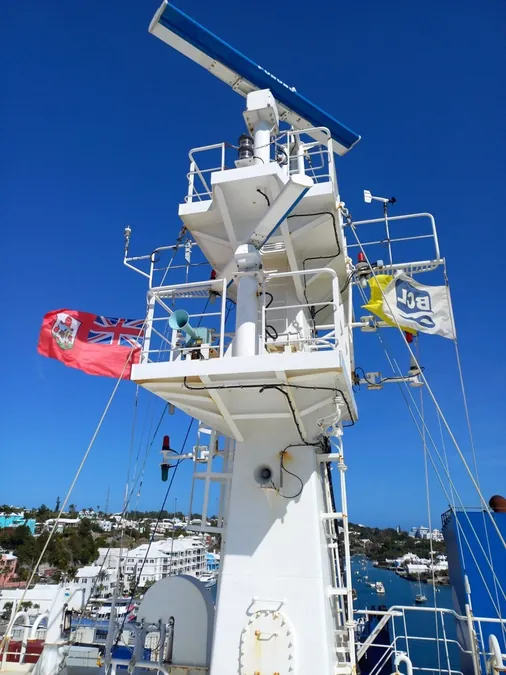
How a Merchant Marine Vessel is Revolutionizing Ocean Data Collection
2025-04-10
Author: Wei
A Game-Changer for Oceanography!
Sustained scientific observations are vital for tracking changes in our oceans. They provide essential data that enhances our understanding of oceanography, biodiversity, and the interconnectedness of global systems, ultimately guiding conservation and resource management efforts.
A Powerful Partnership
In a groundbreaking collaboration, a merchant marine container vessel has teamed up with a cadre of researchers from prestigious institutions, including the Woods Hole Oceanographic Institution (WHOI) and Arizona State University/Bermuda Institute of Ocean Sciences (ASU BIOS). This initiative is paving the way for richer ocean data collection, yielding peer-reviewed findings that enhance public understanding of our seas.
Meet the MV Oleander
The MV Oleander, operated by Bermuda Container Line/Neptune Group, makes weekly voyages between Elizabeth, N.J., and Bermuda. Since the 1970s, three iterations of this vessel have been outfitted with scientific equipment, creating a treasure trove of data. The latest MV Oleander, launched in 2019, is now actively collecting vital measurements of the water column, sea surface, and atmospheric conditions.
Unlocking Secrets of the Atlantic
Crossing crucial currents like the Gulf Stream, the Oleander gives scientists unparalleled access to data on upper ocean currents, water properties, and marine ecology. This oceanic circulatory system, known as the Atlantic Meridional Overturning Circulation (AMOC), plays a significant role in shaping climate and weather patterns across North America and Europe. With climate change in play, monitoring its shifts has never been more urgent.
Key Insights from the Oleander Line
"The continuous observations from the Oleander Line have revealed critical trends about our marine environment, including the warming and shrinking of the Slope Sea," stated Magdalena Andres, senior scientist at WHOI and lead author of a recent study. "More importantly, we're noticing a northward shift in the Gulf Stream, which has wide-ranging implications for climate dynamics."
The Impact of the Gulf Stream
After Cape Hatteras, the Gulf Stream begins to meander, acting as a boundary between varying water masses and enabling ocean air exchange. This self-contained ecosystem is crucial for phytoplankton growth, which feeds the marine food web. Monitoring these intricate processes offers insights that are pivotal for understanding broader oceanic changes.
Academic Collaborations Drive Change
The data harvested from this initiative has significantly contributed to numerous scientific publications and global observation programs, including the Global eXpendable BathyThermograph (XBT) Network and the Surface Ocean CO2 Atlas (SOCAT). Tim Noyes, marine ecologist at ASU BIOS, emphasized, "This collaborative model between researchers and commercial vessels serves as an exemplar for how in situ measurements can augment satellite data in global observing systems."
Innovating with the Science RoCs Initiative
This venture is part of the Science RoCs (Research on Commercial Ships) initiative, which aims to outfit even more commercial vessels with sensors for comprehensive ocean monitoring along major shipping routes. WHOI, along with ASU BIOS and other institutions, leads the Oleander Project.
A Call to Action
Kerry Strom, Senior Manager in WHOI Marine Operations, remarked on the industry's readiness to assist scientists. With the Oleander’s integrated sensors making it a floating interdisciplinary observatory, this collaboration offers a model that could extend access to remote oceanic regions. The success of this initiative demonstrates that partnerships with the merchant marine can significantly broaden our reach, making ocean data collection more robust than ever.


 Brasil (PT)
Brasil (PT)
 Canada (EN)
Canada (EN)
 Chile (ES)
Chile (ES)
 Česko (CS)
Česko (CS)
 대한민국 (KO)
대한민국 (KO)
 España (ES)
España (ES)
 France (FR)
France (FR)
 Hong Kong (EN)
Hong Kong (EN)
 Italia (IT)
Italia (IT)
 日本 (JA)
日本 (JA)
 Magyarország (HU)
Magyarország (HU)
 Norge (NO)
Norge (NO)
 Polska (PL)
Polska (PL)
 Schweiz (DE)
Schweiz (DE)
 Singapore (EN)
Singapore (EN)
 Sverige (SV)
Sverige (SV)
 Suomi (FI)
Suomi (FI)
 Türkiye (TR)
Türkiye (TR)
 الإمارات العربية المتحدة (AR)
الإمارات العربية المتحدة (AR)